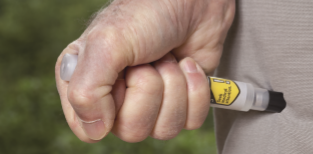AAIs contain a sterile solution of adrenaline either contained in a glass cartridge or pre-filled glass syringe. Jext and Epipen both comprise cartridge type AAI whilst Emerade is a syringe design.
Each AAI device has a different delivery/ administration system. All AAI contain adrenaline solution pressurised to differing degrees. This administration €under pressure€ increases the force of expulsion and enables the adrenaline solution to penetrate deeper into the tissue than the length of the needle.

The currently available AAI provide a range of devices in different strengths to meet the dosage needs of different age groups. Each product will deliver the differing dose either by adjusting the concentration of the adrenaline solution contained within the glass vial or by adjusting the volume of a consistent strength adrenaline solution. This will obviously determine the volume of solution administered from each device.
The EMA has recently undertaken a review of the AAI approved in the EU. This review concluded that:
- Healthcare professionals should prescribe two AAI and patient should be advised to carry both because of uncertainties about the site of drug delivery and speed of adrenaline action
- The product information should include details of the needle length as this is an important consideration when selecting a suitable AAI
- Patients and carers should be trained on the correct use of the AAI supplied. The review required manufacturers to update their educational materials
- EEA requires manufacturers to carry out studies in humans to understand when and how much adrenaline reaches the blood stream, how quickly and effectively it acts on body tissues when administered via an AAI.
Further details of the Drug Safety Update resulting from the EEA review are included in the adrenaline auto-injector medicines safety tip on NumarkNet, which can be found by clicking here.
The EEA review reinforces that there are a number of important factors to consider when selecting a brand of AAI to prescribe or supply.
